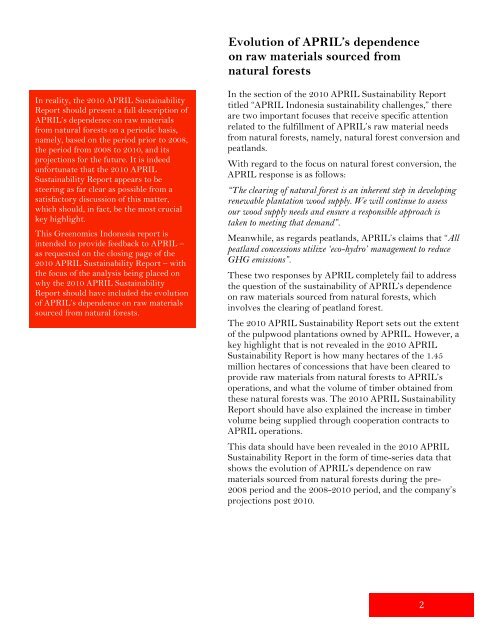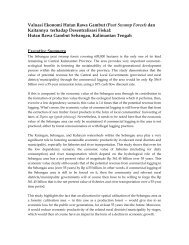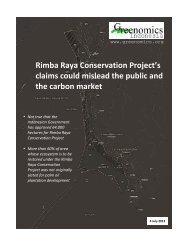Evolution of APRIL's dependence on raw materials sourced from ...
Evolution of APRIL's dependence on raw materials sourced from ...
Evolution of APRIL's dependence on raw materials sourced from ...
You also want an ePaper? Increase the reach of your titles
YUMPU automatically turns print PDFs into web optimized ePapers that Google loves.
<str<strong>on</strong>g>Evoluti<strong>on</strong></str<strong>on</strong>g> <str<strong>on</strong>g>of</str<strong>on</strong>g> APRIL’s <str<strong>on</strong>g>dependence</str<strong>on</strong>g><br />
<strong>on</strong> <strong>raw</strong> <strong>materials</strong> <strong>sourced</strong> <strong>from</strong><br />
natural forests<br />
In reality, the 2010 APRIL Sustainability<br />
Report should present a full descripti<strong>on</strong> <str<strong>on</strong>g>of</str<strong>on</strong>g><br />
APRIL’s <str<strong>on</strong>g>dependence</str<strong>on</strong>g> <strong>on</strong> <strong>raw</strong> <strong>materials</strong><br />
<strong>from</strong> natural forests <strong>on</strong> a periodic basis,<br />
namely, based <strong>on</strong> the period prior to 2008,<br />
the period <strong>from</strong> 2008 to 2010, and its<br />
projecti<strong>on</strong>s for the future. It is indeed<br />
unfortunate that the 2010 APRIL<br />
Sustainability Report appears to be<br />
steering as far clear as possible <strong>from</strong> a<br />
satisfactory discussi<strong>on</strong> <str<strong>on</strong>g>of</str<strong>on</strong>g> this matter,<br />
which should, in fact, be the most crucial<br />
key highlight.<br />
This Greenomics Ind<strong>on</strong>esia report is<br />
intended to provide feedback to APRIL –<br />
as requested <strong>on</strong> the closing page <str<strong>on</strong>g>of</str<strong>on</strong>g> the<br />
2010 APRIL Sustainability Report – with<br />
the focus <str<strong>on</strong>g>of</str<strong>on</strong>g> the analysis being placed <strong>on</strong><br />
why the 2010 APRIL Sustainability<br />
Report should have included the evoluti<strong>on</strong><br />
<str<strong>on</strong>g>of</str<strong>on</strong>g> APRIL’s <str<strong>on</strong>g>dependence</str<strong>on</strong>g> <strong>on</strong> <strong>raw</strong> <strong>materials</strong><br />
<strong>sourced</strong> <strong>from</strong> natural forests.<br />
In the secti<strong>on</strong> <str<strong>on</strong>g>of</str<strong>on</strong>g> the 2010 APRIL Sustainability Report<br />
titled “APRIL Ind<strong>on</strong>esia sustainability challenges,” there<br />
are two important focuses that receive specific attenti<strong>on</strong><br />
related to the fulfillment <str<strong>on</strong>g>of</str<strong>on</strong>g> APRIL’s <strong>raw</strong> material needs<br />
<strong>from</strong> natural forests, namely, natural forest c<strong>on</strong>versi<strong>on</strong> and<br />
peatlands.<br />
With regard to the focus <strong>on</strong> natural forest c<strong>on</strong>versi<strong>on</strong>, the<br />
APRIL resp<strong>on</strong>se is as follows:<br />
“The clearing <str<strong>on</strong>g>of</str<strong>on</strong>g> natural forest is an inherent step in developing<br />
renewable plantati<strong>on</strong> wood supply. We will c<strong>on</strong>tinue to assess<br />
our wood supply needs and ensure a resp<strong>on</strong>sible approach is<br />
taken to meeting that demand”.<br />
Meanwhile, as regards peatlands, APRIL’s claims that “All<br />
peatland c<strong>on</strong>cessi<strong>on</strong>s utilize ‘eco-hydro’ management to reduce<br />
GHG emissi<strong>on</strong>s”.<br />
These two resp<strong>on</strong>ses by APRIL completely fail to address<br />
the questi<strong>on</strong> <str<strong>on</strong>g>of</str<strong>on</strong>g> the sustainability <str<strong>on</strong>g>of</str<strong>on</strong>g> APRIL’s <str<strong>on</strong>g>dependence</str<strong>on</strong>g><br />
<strong>on</strong> <strong>raw</strong> <strong>materials</strong> <strong>sourced</strong> <strong>from</strong> natural forests, which<br />
involves the clearing <str<strong>on</strong>g>of</str<strong>on</strong>g> peatland forest.<br />
The 2010 APRIL Sustainability Report sets out the extent<br />
<str<strong>on</strong>g>of</str<strong>on</strong>g> the pulpwood plantati<strong>on</strong>s owned by APRIL. However, a<br />
key highlight that is not revealed in the 2010 APRIL<br />
Sustainability Report is how many hectares <str<strong>on</strong>g>of</str<strong>on</strong>g> the 1.45<br />
milli<strong>on</strong> hectares <str<strong>on</strong>g>of</str<strong>on</strong>g> c<strong>on</strong>cessi<strong>on</strong>s that have been cleared to<br />
provide <strong>raw</strong> <strong>materials</strong> <strong>from</strong> natural forests to APRIL’s<br />
operati<strong>on</strong>s, and what the volume <str<strong>on</strong>g>of</str<strong>on</strong>g> timber obtained <strong>from</strong><br />
these natural forests was. The 2010 APRIL Sustainability<br />
Report should have also explained the increase in timber<br />
volume being supplied through cooperati<strong>on</strong> c<strong>on</strong>tracts to<br />
APRIL operati<strong>on</strong>s.<br />
This data should have been revealed in the 2010 APRIL<br />
Sustainability Report in the form <str<strong>on</strong>g>of</str<strong>on</strong>g> time-series data that<br />
shows the evoluti<strong>on</strong> <str<strong>on</strong>g>of</str<strong>on</strong>g> APRIL’s <str<strong>on</strong>g>dependence</str<strong>on</strong>g> <strong>on</strong> <strong>raw</strong><br />
<strong>materials</strong> <strong>sourced</strong> <strong>from</strong> natural forests during the pre-<br />
2008 period and the 2008-2010 period, and the company’s<br />
projecti<strong>on</strong>s post 2010.<br />
2







